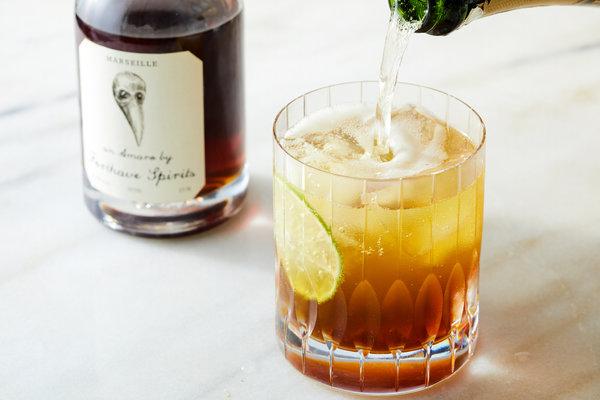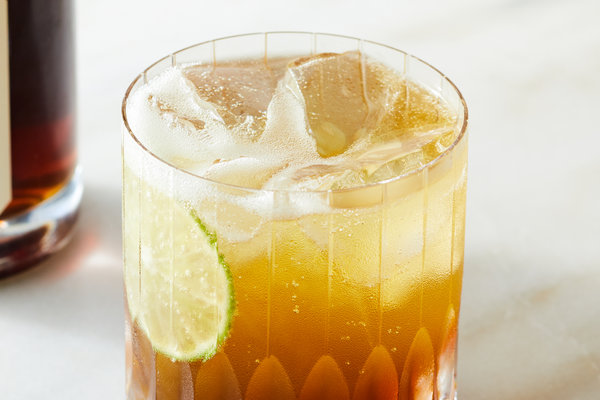It’s late spring, 6 p.m. Golden hour is nigh. It’s too late for lemonade, too early for whiskey — spritz time on the dot.
Italy has been perfecting spritz hour for decades, and now #spritzlife (yes, it’s a hashtag) has fully bubbled up across the Atlantic, due in no small part to a 2017 marketing push from Aperol’s maker, Campari America: a coast-to-coast Aperol spritz campaign.
The drink possesses qualities that I can get behind. It’s effervescent, it’s extremely well iced and it is a shade of orange that rivals a “Planet Earth” sunset. It exists within the broader category of apéritifs, or aperitivos: the low-alcohol, often bitter-leaning drinks (as well as the bottles on which they are based) that are meant to prime your palate for the evening to come.
But there is a problem: The Aperol spritz isn’t actually good.
Served in branded, jumbo wine glasses, the sugary apéritif is paired with low-quality prosecco, soda water and an outsize orange slice, resulting in something that drinks like a Capri Sun after soccer practice on a hot day. Not in a good way.
Despite the figures — both sales and social media likes — I’m not alone in this opinion.
First, there is the Aperol. Though it contains ingredients like bitter oranges and rhubarb, the bottle skews saccharine at best, with a syruplike finish.
“Aperol isn’t my favorite aperitivo,” said Katie Parla, an American living in Rome and the author of the recent cookbook “Food of the Italian South.” “I like something that’s way more bitter. It lacks the complexity of some of the other competitors.” Ms. Parla has seen the rise in Aperol-branded spritzes and accompanying merchandise on both sides of the Atlantic; there was a similarly drastic upswing in Aperol-spritz consumption in Italy after Campari bought the brand in 2003.
But the sparkling wine that’s added to the drink is often an issue, too.
Most spritzes are “heavy on terrible quality, sweet prosecco,” Ms. Parla said. And if the Aperol spritz isn’t served immediately, she added, “the ice melts and dilutes things so you get a watered-down version of something that’s not even the best expression of the drink.”

Pass on the bad prosecco, and opt for a pétillant naturel or another quality sparkling wine.CreditRyan Liebe for The New York Times. Food Stylist: Barrett Washburne.
To be called a spritz, a drink needs only to loosely follow a formula: three parts bubbly, two parts bitter, one part soda. Add citrus.
We have Austrian soldiers to thank for the drink’s name. In the 19th century, men stationed in northern Italy and unaccustomed to the local style of wine started diluting glasses with a spritz — the German word for “spray” — of still water. Soda water replaced still water in the late 1910s, bitter wine- or spirit-based apéritifs were swapped in for wine in the ’20s and early ’30s, and prosecco got its skin in the game in the ’90s.
For me, a well-made spritz is an ideal opener to the night. The best ones are more nuanced than the Aperol spritz, but no more complicated. If your finished drink tastes like a children’s vitamin, it’s wrong, and it’s a hangover biding its time.
To build a spritz worth drinking, direct your attention first to the sparkling wine, then the apéritif bottle. In the 3:2:1 formula, sparkling wine takes up the most real estate, and most spritzes are being topped with garbage bubbles.
“I think people have the misconception that if you’re mixing it into something it doesn’t matter, because you’re not going to be able to tell,” said Natasha David, the owner of Nitecap, a bar in New York that dedicates an entire section of the menu to spritzes. “But it does indeed matter.”
When deciding on bubbles, quality prosecco is a good choice, though by no means the only one. There’s no need to dilute very good Champagne over ice, but I often opt for a pétillant naturel (often shortened to pèt-nat). Whatever it is, make it dry, open it fresh, and serve it fast.
Choose your apéritif bottle next. Pick something you’re already likely to drink chilled or on the rocks. Bitter reds work, especially if you’re keen to keep things brightly hued; my home bar currently features Cappelletti, Contratto Bitter and Forthave Spirits Red Aperitivo. Vermouths skew the resulting cocktail slightly sweet, though not as quite sweet as Aperol. When I deploy vermouth at apéritif hour, I go with sweet red or sweet white, and balance it with seltzer, tonic or some combination of the two. I top the drink with a big green olive. This summer, however, if you’re spritzing with me, an amaro is going to get involved.
If you’re making them at home, know that spritzes are zero-intimidation cocktails — easy to make, easier still to drink. Forgo any tools besides the jigger; spritzes are built in the glass, and the garnish can do the mixing as it drops into the drink.
As we enter high spritz season, start with the following recipes, then make up your own. That’s the point isn’t it? To think, and drink, for yourself.
Recipes: Amaro Spritz | Tonic Spritz









